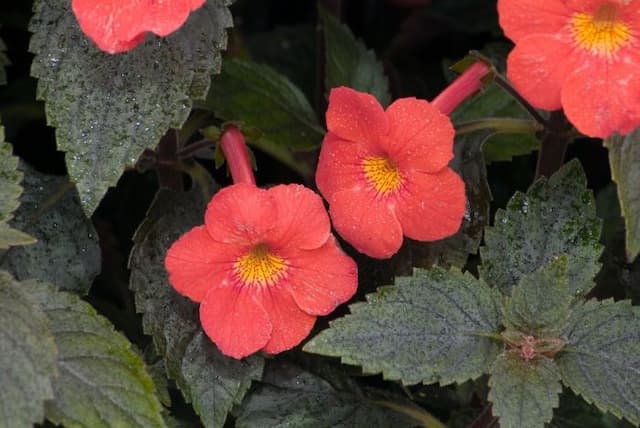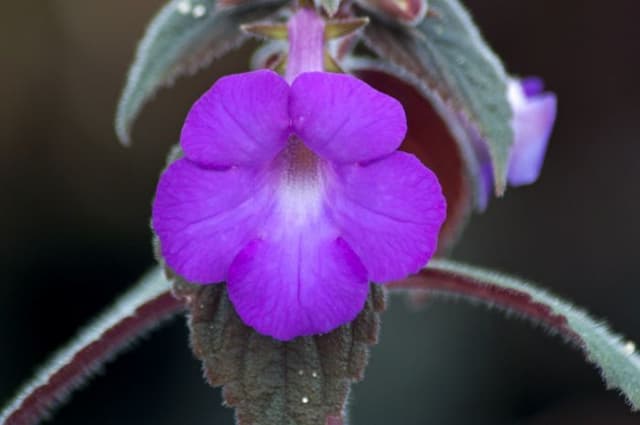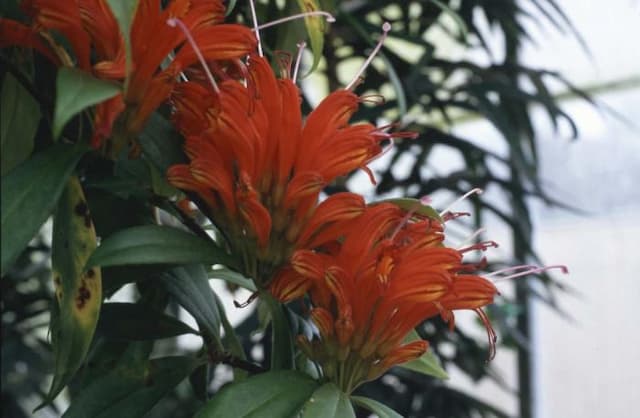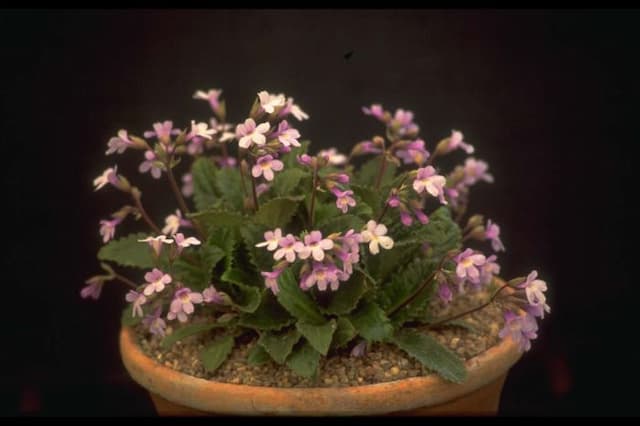Cape primrose 'White Butterfly' Streptocarpus 'White Butterfly'

ABOUT
A tender perennial, up to 30cm high, with oval, green, softly-hairy leaves and upright stems carrying sprays of white flowers, 2.5cm across, throughout the year
About this plant
 Names
NamesFamily
Gesneriaceae
Synonyms
Cape Primrose, African Violet Cousin
Common names
Streptocarpus 'White Butterfly'
 Characteristics
CharacteristicsLife cycle
Perennials
Foliage type
Evergreen
Color of leaves
Green
Flower color
White
Height
1 foot (30 centimeters)
Spread
1 foot (30 centimeters)
Plant type
Herb
Hardiness zones
10
Native area
Africa
Benefits
 General Benefits
General Benefits- Ornamental Appeal: Streptocarpus 'White Butterfly', commonly known as Cape Primrose, offers a visually appealing aesthetic with its delicate white blooms that resemble butterflies, adding elegance to indoor and outdoor spaces.
- Long Blooming Period: This variety is known for its long flowering season, providing a continuous display of blooms for much of the year.
- Low Maintenance: Cape Primrose is relatively easy to care for, requiring minimal attention compared to other flowering houseplants, making it ideal for busy plant lovers.
- Compact Growth: With its compact growth habit, Cape Primrose is well-suited for small spaces and windowsills, allowing for a lush look without requiring a lot of room.
- Variety of Uses: It can be used in a variety of settings, such as in hanging baskets, containers, or as a standalone feature on a table or desk.
- Adaptability: Streptocarpus 'White Butterfly' can adapt to a range of indoor lighting conditions, from bright, indirect light to partial shade, making it versatile for different home environments.
- Propagate Easily: They are fairly easy to propagate from leaf cuttings or division, allowing plant enthusiasts to easily multiply their collection or share with others.
 Medical Properties
Medical PropertiesThis plant is not used for medical purposes.
 Air-purifying Qualities
Air-purifying QualitiesThis plant is not specifically known for air purifying qualities.
 Other Uses
Other Uses- Art and Illustration: The striking appearance of the Streptocarpus 'White Butterfly' makes it an attractive subject for botanical artists and illustrators aiming to capture its unique beauty.
- Photography Prop: The delicate white flowers can serve as an elegant prop in macro photography, offering a natural contrast for vibrant compositions.
- Educational Material: This plant can be used in educational settings to teach about hybridization, plant care, and the diversity of flowering houseplants.
- Mood Enhancement: Positioned in a workspace or living area, the 'White Butterfly' can contribute to a calming atmosphere and potentially enhance mood due to its serene appearance.
- Theme Gardens: It fits well in a white-themed garden or moon garden, where plants with pale flowers create a luminous effect in the twilight.
- Flower Arranging: While not commonly used, the individual flowers could be floated in shallow bowls of water for elegant centerpieces at events.
- Crafting: Dried petals can be used in crafting, such as for making natural confetti or inclusion in homemade paper for an artistic touch.
- Collecting: Enthusiasts of Streptocarpus or gesneriad plants may cultivate 'White Butterfly' as part of a specialty collection of rare or interesting houseplants.
- Seasonal Decor: The plant could be used as a living decoration during the winter holidays, as its white flowers can complement a snowy theme.
- Gift Plant: With its appealing aesthetic, it can be given as a thoughtful gift to plant lovers or those appreciating delicate flowers at home or office.
Interesting Facts
 Feng Shui
Feng ShuiThe Cape Primrose is not used in Feng Shui practice.
 Zodiac Sign Compitability
Zodiac Sign CompitabilityThe Cape Primrose is not used in astrology practice.
 Plant Symbolism
Plant Symbolism- Purity: The white color of the Streptocarpus 'White Butterfly' blooms embodies purity and innocence, similar to the symbolism of white flowers in various cultures.
- Transformation: The name "Butterfly" suggests transformation and beauty, in line with the metamorphosis that butterflies go through, reflecting change and hope.
- Elegance: With its delicate and graceful flowers, the 'White Butterfly' resonates with a symbol of elegance and poise.
- Peace: White flowers are often associated with peace and tranquility, and the 'White Butterfly' Streptocarpus may convey a sense of calmness.
- New Beginnings: The 'White Butterfly' Streptocarpus can represent new beginnings, as white is also the color of fresh starts, often used in ceremonies like weddings.
 Water
WaterCape Primrose requires consistent moisture but dislikes being waterlogged. Water the plant when the top inch of soil begins to feel dry, typically once a week, depending on the environmental conditions. Use room temperature water, pouring gently at the base of the plant to avoid wetting the leaves. Provide approximately 8-12 ounces of water each time to thoroughly moisten the soil, but ensure any excess water drains away to prevent root rot.
 Light
LightCape Primrose thrives best in bright, indirect light. Place it near a window where it can receive filtered sunlight, away from direct rays which can scorch the leaves. An east or north-facing windowsill is an ideal spot for this plant as it provides the soft light conditions it prefers.
 Temperature
TemperatureCape Primrose enjoys moderate temperatures and should be kept between 60 to 75 degrees Fahrenheit for optimal growth. It can tolerate a minimum temperature of 50 degrees Fahrenheit but should be protected from drafts and sudden temperature changes. The ideal temperature range ensures the plant stays healthy and encourages blooming.
 Pruning
PruningRegularly prune your Cape Primrose to remove any yellowing or dead leaves and spent flower stems to encourage new growth and maintain a tidy appearance. Light pruning can be done throughout the year as needed. The best time for significant pruning is immediately after the main bloom cycle, often in late spring or early summer.
 Cleaning
CleaningAs needed
 Soil
SoilThe ideal soil mix for Cape Primrose should be light and airy, with excellent drainage to prevent waterlogging and root rot. A good mixture consists of half potting soil and half perlite or vermiculite. The pH should be slightly acidic to neutral, ranging from 6.0 to 7.0.
 Repotting
RepottingCape Primroses should be repotted annually to refresh the soil and provide room for growth. However, they prefer to be slightly root-bound, so only upsize the pot if necessary.
 Humidity & Misting
Humidity & MistingCape Primrose thrives in moderate to high humidity levels, with the ideal range being between 50% and 70%.
 Suitable locations
Suitable locationsIndoor
Place in bright, indirect light and maintain high humidity.
Outdoor
Only in summer; shaded location with high humidity.
Hardiness zone
10-11 USDA
 Life cycle
Life cycleCape primrose 'White Butterfly' begins its life as a seed, which after germination, develops into a small rosette of leaves. As a young plant, it grows larger, elongated, fuzzy leaves and begins to form a robust root system. Upon reaching maturity, which takes several months, the plant starts to flower with delicate white blooms, often featuring fine lines or strokes in the throat, resembling the patterns on a butterfly's wings. The flowering phase can last for several months, with the plant capable of blooming almost continuously if provided with favorable conditions and proper care. After the flowering stage, the plant produces seeds, which can be collected for propagation, continuing the life cycle. Over several years, the plant will reach the end of its life cycle, though with careful pruning and rejuvenation, it can be encouraged to keep producing new growth and flowers.
 Propogation
PropogationPropogation time
Spring-Early Summer
Propogation: Streptocarpus 'White Butterfly', commonly known as Cape Primrose, can be propagated through leaf cuttings, which is the most popular method. This process is best done in the spring or early summer when the plant is actively growing. To propagate, a healthy leaf is chosen, and a horizontal cut is made through the leaf, including the vein. This leaf is then placed on a moist potting mix, ensuring the cut side is in contact with the soil. It's important to maintain humidity, which can be done by covering the pot with a plastic bag, and to keep the potting mix lightly moist but not wet. In a few weeks, new plantlets will form at the cut edges of the leaf. Once they've grown large enough to handle, they can be gently separated and potted individually.









